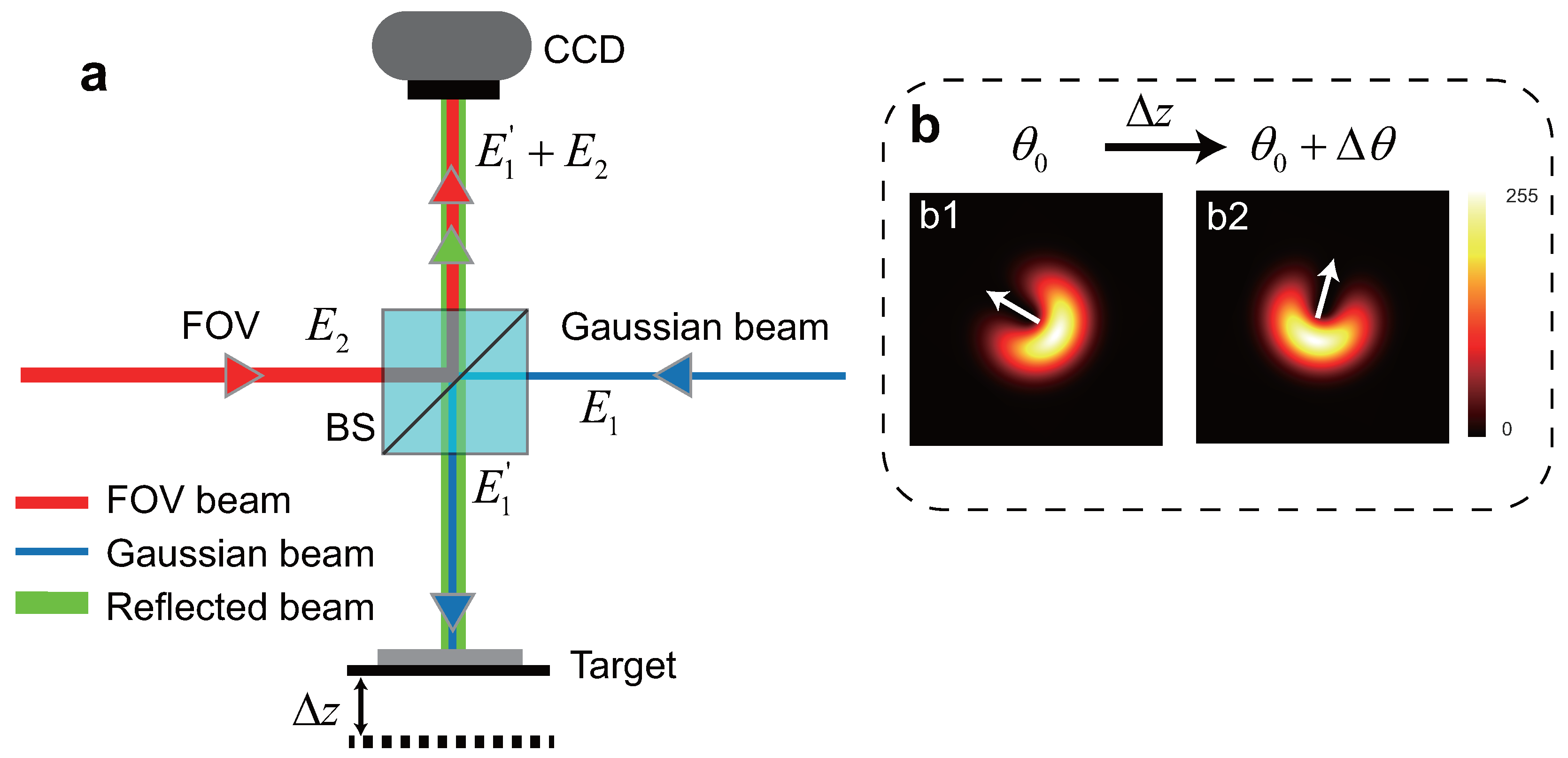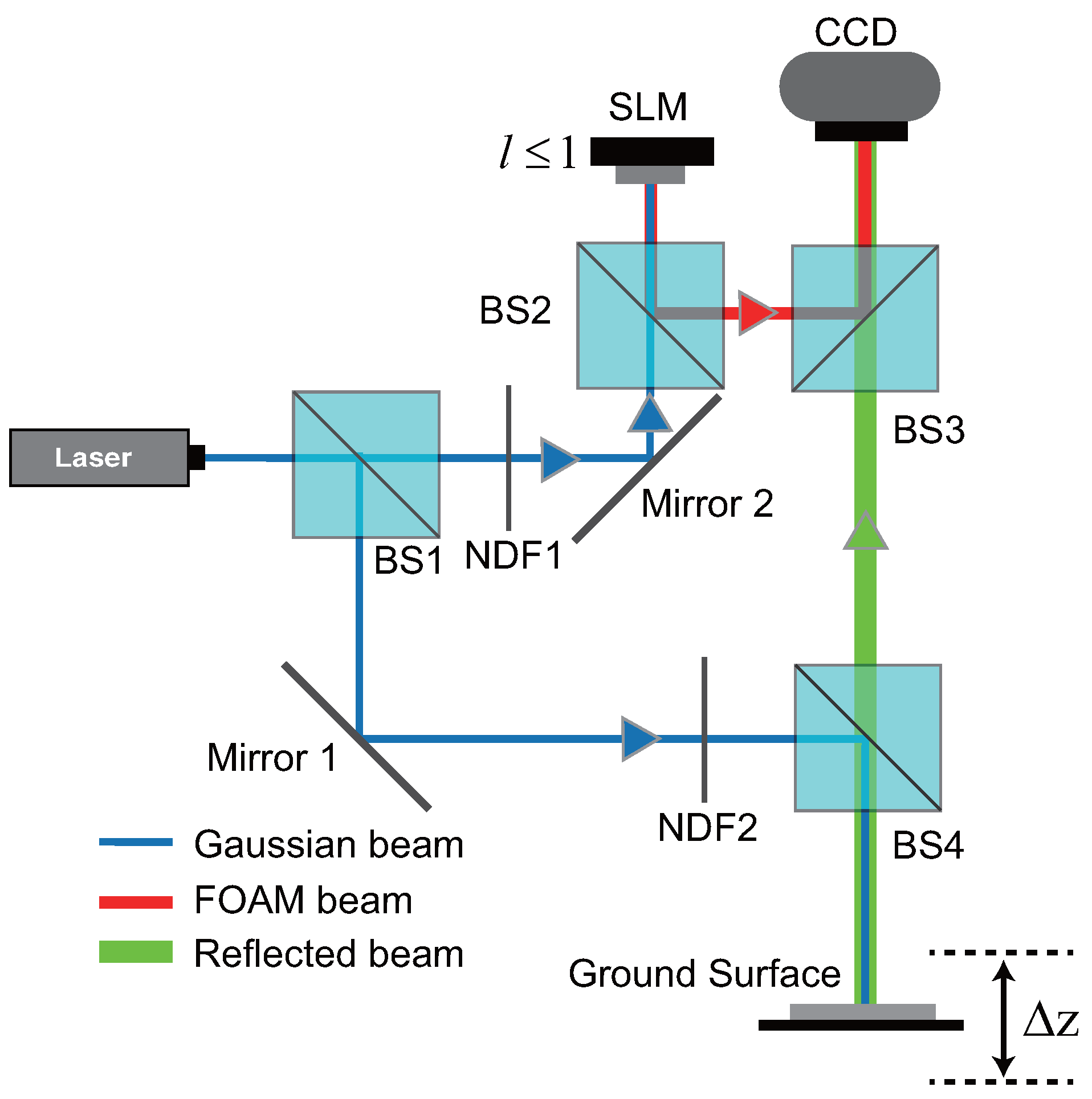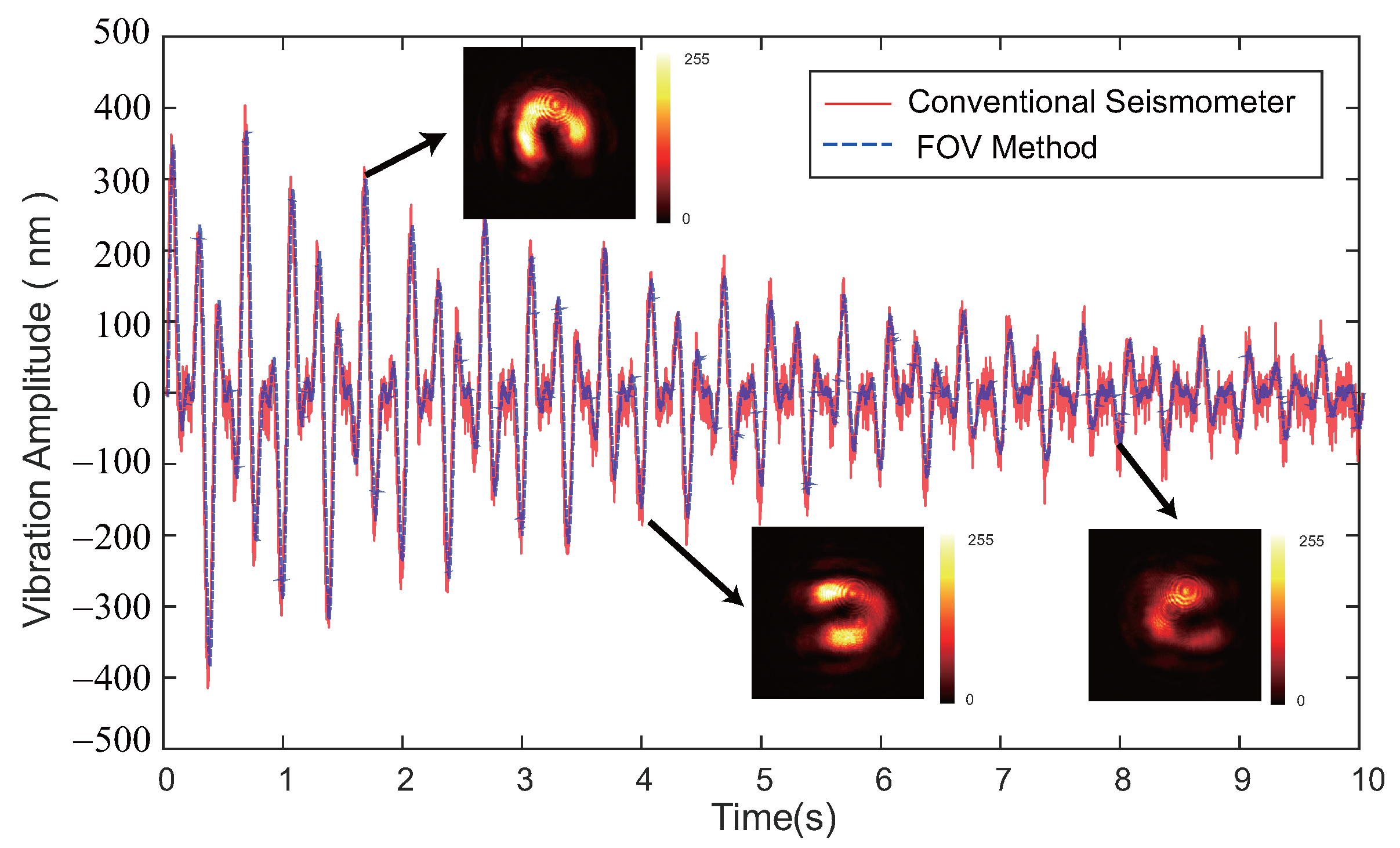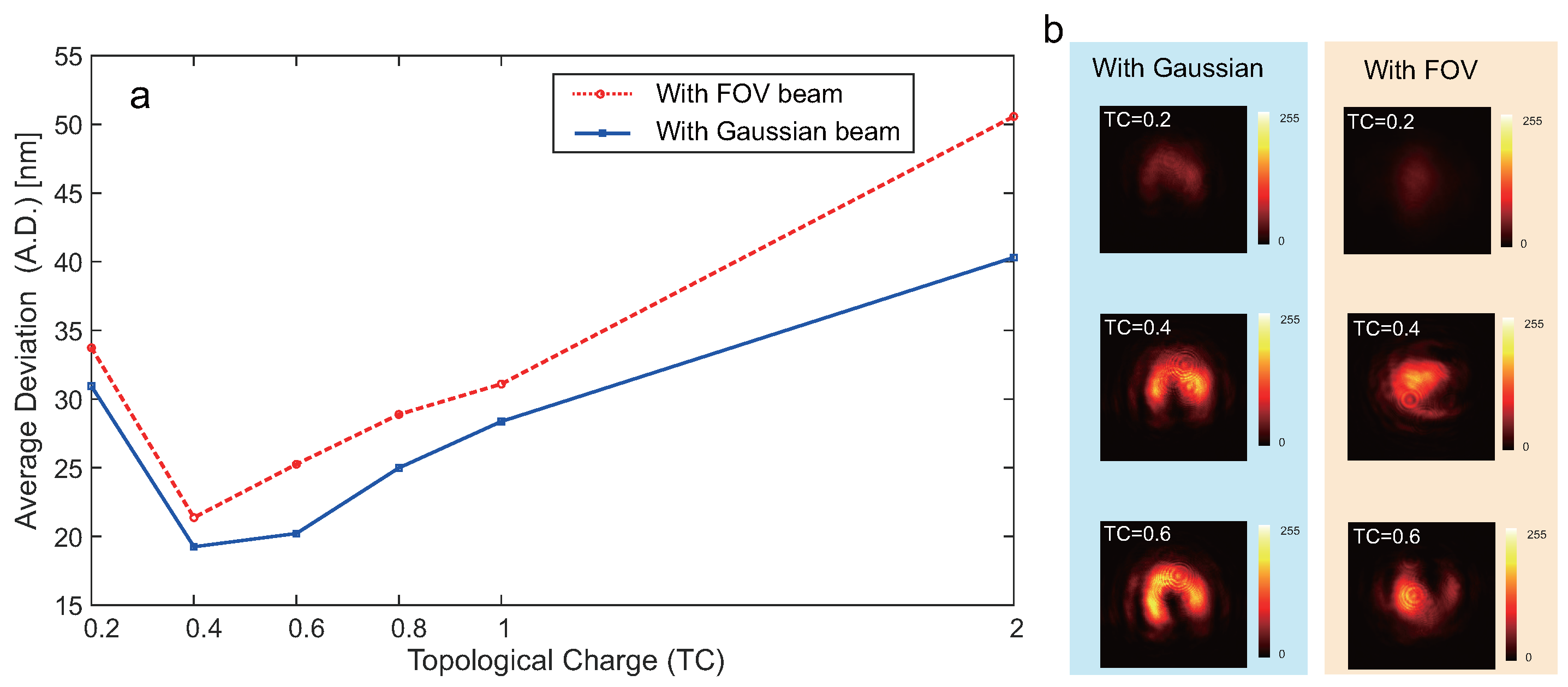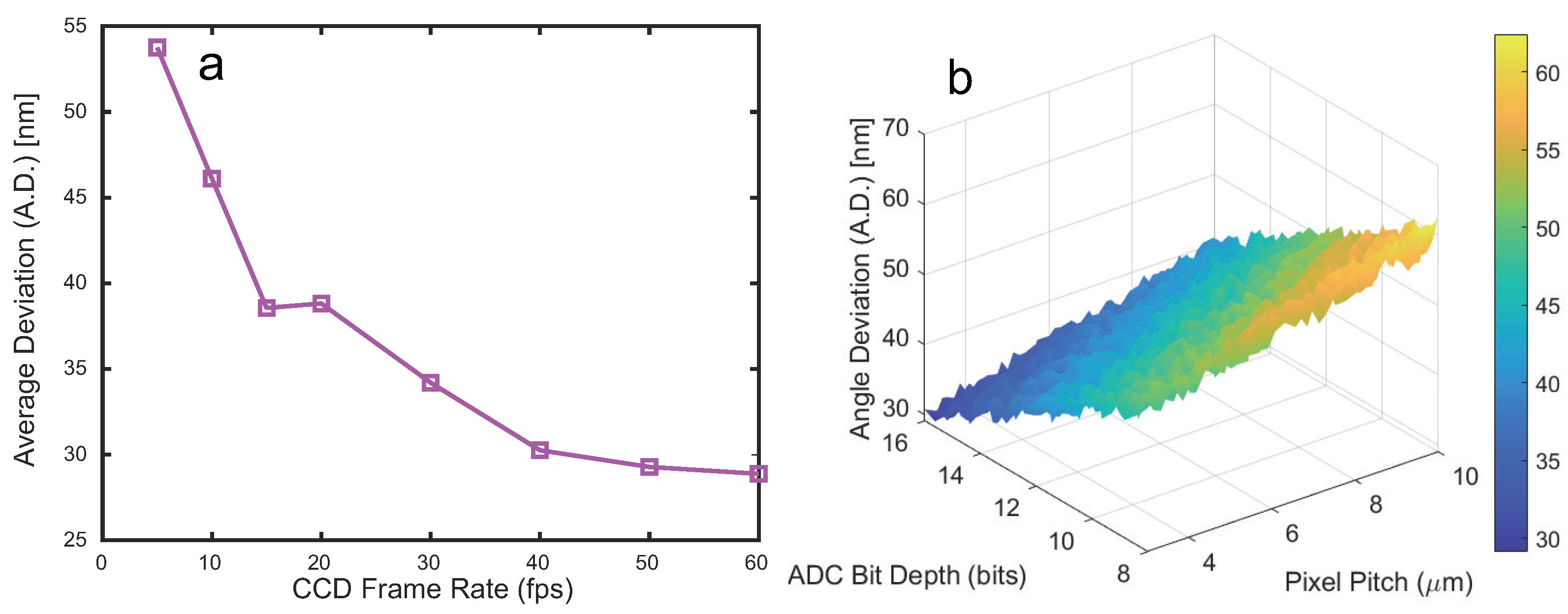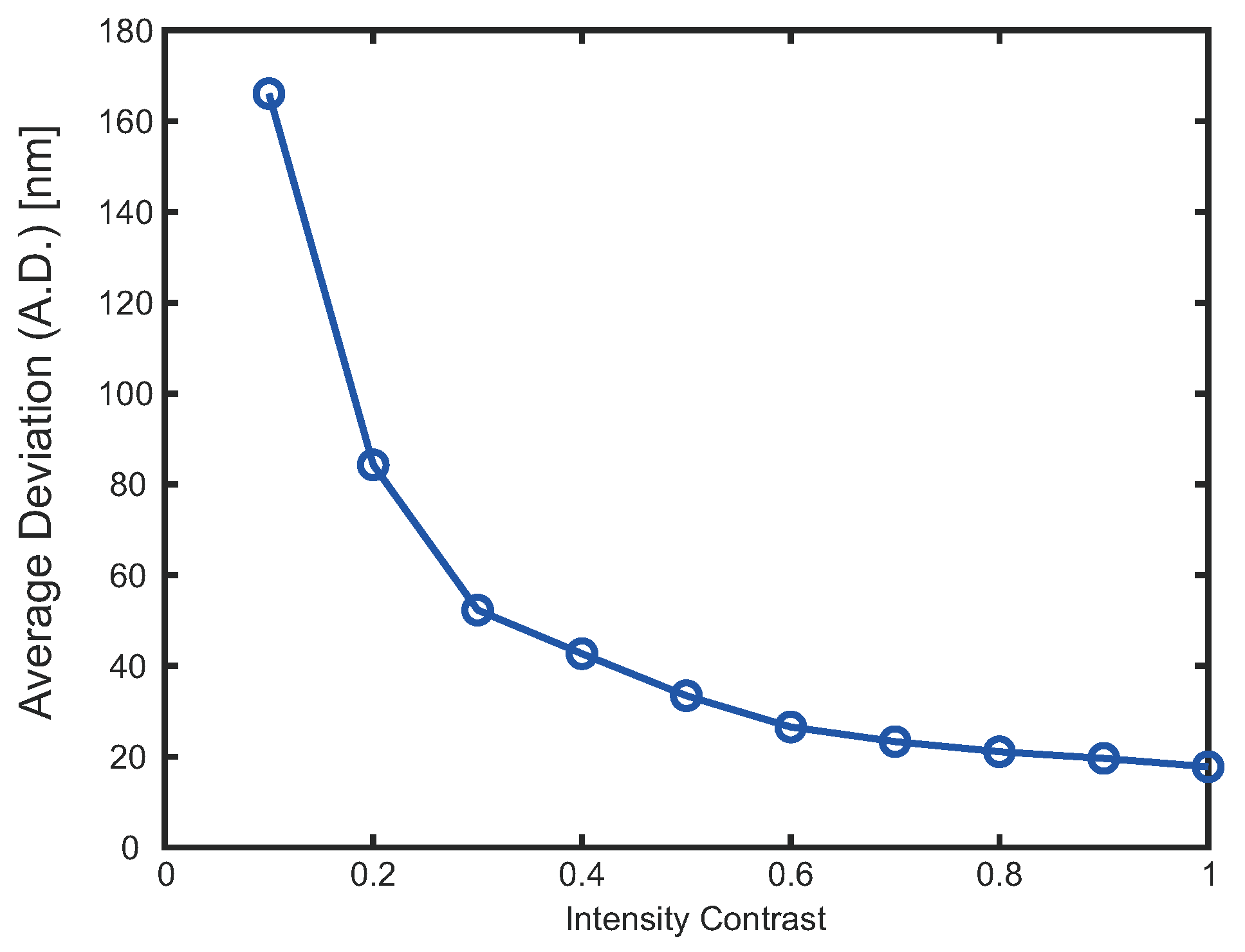1. Introduction
Recent advancements in optical micro-vibration measurement have significantly enhanced the precision and applicability of vibration analysis across various scientific and industrial domains. Innovations in optical sensing and computational techniques have led to the development of non-contact, high-resolution methods capable of detecting minute vibrational displacements [
1].
One notable development is the application of deep learning in vision-based measurement systems. A study by Li et al. introduced a deep learning-based vision measurement method designed to accurately measure micro-vibration displacements of objects across different scenarios. This approach leverages advanced image processing algorithms to detect subtle vibrational movements, demonstrating improved accuracy over traditional methods [
2]. Laser Doppler vibrometry (LDV) remains a cornerstone in optical vibration measurement, offering non-contact analysis with high sensitivity. LDV systems utilize the Doppler effect to measure velocity and displacement of vibrating surfaces, making them particularly suitable for delicate or inaccessible targets [
3]. Advancements in optical accelerometers have also contributed to the field. These devices employ optical measurement techniques to achieve high-precision and electromagnetic interference-resistant acceleration measurements, proving beneficial in applications such as structural health monitoring and precision vibration isolation systems [
4].
Furthermore, the integration of self-mixing interferometry has enabled the measurement of micro-harmonic vibrations with enhanced sensitivity. This technique involves the reinjection of reflected light into the laser cavity, allowing for the detection of minute vibrational changes through modulation of the laser output [
5,
6,
7]. In summary, the field of optical micro-vibration measurement has witnessed substantial progress through the incorporation of advanced optical sensing technologies and computational methods. These developments have expanded the capabilities of vibration analysis, enabling more precise and versatile applications across various sectors.
Optical vortices (OVs) carrying orbital angular momentum (OAM) offer several advantages in micro vibration measurement [
8,
9]. The integration of vortex beams into micro-vibration measurement has garnered significant attention in recent research, offering novel methodologies for enhancing measurement precision and sensitivity. OAM beams, characterized by their helical phase fronts and the ability to carry quantized angular momentum, present unique advantages in detecting and analyzing micro vibrations [
10].
In our previous work [
11], we introduced a dynamic micro-vibration measurement technique leveraging OV. Our approach utilizes the rotational Doppler effect inherent in OV beams to detect micro-vibrations with high sensitivity. The study demonstrated that variations in the frequency shift of the reflected OV beam correlate directly with the amplitude and frequency of the micro-vibrations, enabling precise measurements. This method underscores the potential of OV beams in enhancing the detection capabilities for micro-vibration analysis. In the realm of beam characterization, Grunwald and Bock proposed a technique involving polar mapping and Fourier transform to analyze OV beams [
12]. This method facilitates the detailed examination of beam profiles, which is crucial for applications requiring precise beam manipulation, including micro-vibration measurements. Furthermore, Zhang et al. developed an all-fiber laser system capable of generating pulsed polarized vortex beams [
13]. This innovation offers a compact and efficient source of OV beams, which can be instrumental in micro-vibration measurement setups where space and system integration are critical considerations.
These advancements collectively highlight the emerging role of vortex beams in micro-vibration measurement research. The unique properties of OAM beams, such as their helical phase structure and angular momentum characteristics, provide new avenues for developing high-precision measurement techniques. Continued exploration in this field is poised to yield further innovations, enhancing the capabilities and applications of micro-vibration measurement technologies.
Despite the promising capabilities of OV beams in micro-vibration measurement, several inherent limitations hinder their effectiveness. Firstly, the petal-shaped interference patterns generated by the superposition of OV and Gaussian beams often exhibit morphological similarities, especially when employing low topological charges (TCs). This resemblance complicates the accurate determination of rotation angles, thereby affecting the precision of vibration measurements. Secondly, OV beams are particularly susceptible to distortions arising from environmental factors such as atmospheric turbulence, optical misalignments, and scattering. These distortions can degrade the beam quality, leading to inaccuracies in the measurement process. Addressing these challenges is crucial for enhancing the reliability and accuracy of OV-based micro-vibration measurement systems.
To address these limitations, the concept of fractional optical vortex (FOV) beams has emerged. Unlike integer optical vortex (OV) beams, fractional optical vortex (FOV) beams carry non-integer topological charges, resulting in asymmetric intensity distributions characterized by distinct radial dark regions [
14,
15]. These unique intensity profiles have demonstrated advantages in applications such as optical communication [
16,
17], optical tweezers [
18,
19], and optical displays [
20,
21]. Despite these advancements, the potential of FOV beams in optical sensing, particularly in micro-vibration measurement, remains underexplored. The non-uniform intensity characteristics of FOV beams could offer novel pathways to enhance sensitivity and robustness in micro-vibration detection systems. Recent studies have begun to investigate the application of orbital angular momentum (OAM) beams in vibration sensing, demonstrating promising results. Building upon this foundation, this study aims to investigate the application of FOV beams in micro-vibration measurement, exploring their potential to overcome existing challenges and improve measurement precision.
In this paper, we propose a dynamic micro-vibration monitoring method based on fractional optical vortex. In this approach, a Gaussian beam is used as the measurement beam, while a fractional optical vortex (FOV) beam serves as the reference beam. When the topological charge (TC) of the FOV beam is less than or equal to 1 (), a single petal-like intensity is generated, which significantly reduces the complexity of angular measurement. The measurement beam is directed onto the target, and the reflected light carries information about the vibration amplitude of the surface. When the target undergoes vibration, the single petal-like intensity in the interference pattern rotates clockwise or counterclockwise around the dark core, depending on the direction of micro-vibration.
Compared with the conventional integer-order vortex beam method [
11], the proposed FOV approach offers two major advantages. First, by leveraging the non-uniform intensity distribution of the FOV beam, our method generates a single petal-like intensity. This significantly simplifies the measurement of rotational angle compared to the multiple petals produced by integer-vortex beams. Second, we employ a Gaussian beam as the measurement beam instead of the vortex beam, which reduces the spatial distortion and beam deformation during propagation. This leads to improved stability and accuracy in vibration amplitude detection.
4. Discussion
4.1. Effect of TC on Measurement Accuracy
The topological charge (TC) plays a crucial role in determining the angular resolution of petal-based measurement using fractional-order vortex (FOV) beams. As the TC increases, the number of petal-like intensity lobes also increases, leading to reduced angular distinguishability for each lobe. Conversely, at very low TC values (), the petal becomes more pronounced and easier to track.
Figure 5 shows the experimental relationship between TC and the resulting angular deviation (A.D.) in measurement. In this experiment, the measurement beam with FOV beam and Gaussian beam are shown in
Figure 5a. Compared to the Gaussian beam, the FOV beam yields slightly reduced performance, mainly because it is more vulnerable to environmental perturbations that tend to distort its spatial structure. The results also demonstrate that as TC increases from 0.2 to 2, the measurement error grows exponentially. This trend suggests that an optimal TC exists—typically around 0.5 to 1—where the petal is both distinguishable and stable for angular tracking. Thus, careful selection of TC is essential to balance pattern clarity and spatial modulation capability in FOV-based vibration sensing. However, if the TC is too small, as shown in
Figure 5b, the vortex beam may not exhibit a clearly defined azimuthal structure, limiting robustness.
4.2. Effect of CCD Performance on Measurement Accuracy
The performance of the CCD detector plays a critical role in determining the overall accuracy and robustness of the proposed petal-tracking vibration measurement system. Specifically, three major parameters—frame rate, pixel pitch, and ADC bit depth—influence the precision of angular displacement extraction, as shown in
Figure 6.
The frame rate of the CCD camera plays a crucial role in determining the temporal resolution and accuracy of vibration measurements. A higher frame rate enables denser temporal sampling of the rotating petal-like patterns generated by the interference of the FOV and Gaussian beams, allowing for more precise tracking of angular changes. In contrast, a lower frame rate may result in under-sampling of the vibration-induced angular shifts, leading to aliasing, temporal ambiguity, and reduced measurement accuracy—particularly for high-frequency vibrations.
In this study, a series of experiments were conducted at varying frame rates to evaluate the effect on angle deviation (A.D.). The results show that when the CCD frame rate falls below the Nyquist sampling criterion of the vibration frequency, the extracted angular displacement becomes unreliable and prone to abrupt jumps between consecutive frames. Conversely, frame rates exceeding this threshold yield smoother and more accurate angular trajectories, with a corresponding reduction in A.D.
Figure 6a illustrates the comparison between different CCD frame rates, highlighting the substantial improvement in measurement stability and accuracy as the frame rate increases. It is also worth noting that while extremely high frame rates offer improved resolution, they may introduce additional system complexity, data volume, and synchronization challenges. Therefore, a trade-off must be considered between temporal resolution and system efficiency in practical applications.
In additon, the CCD frame rate should be at least two to three times greater than the highest significant vibration frequency to ensure robust sampling and avoid aliasing. For example, if the dominant vibration frequency is around 50 Hz, a frame rate of at least 100–150 fps should be used. For applications involving broader or higher-frequency spectra, even higher frame rates may be necessary to preserve measurement fidelity.
As shown in
Figure 6b, a smaller pixel pitch enhances the spatial sampling resolution, allowing for finer localization of the intensity minima or maxima along the petal profile. This directly reduces spatial quantization errors and improves the angular resolution of the vibration measurement. In contrast, a larger pixel pitch may introduce sampling artifacts, especially when tracking subtle petal rotations corresponding to small vibration amplitudes. The ADC bit depth affects the system’s ability to resolve intensity variations within the interference pattern. A higher bit depth provides a greater number of discrete intensity levels, minimizing quantization noise and allowing for more accurate identification of the petal feature points. In practical terms, scientific-grade CCDs typically offer 12- to 16-bit ADCs, which are sufficient to capture the dynamic range needed for reliable measurement in this system.
Overall, when employing a CCD with typical scientific-grade specifications (pixel pitch 3.45–6.5 µm, ADC resolution 12–16 bits, and frame rate exceeding twice the maximum vibration frequency according to the Nyquist criterion), the influence of detector limitations on the measurement accuracy is minimized. Under such conditions, other factors such as optical distortions, environmental vibrations, and beam quality become the dominant sources of measurement uncertainty.
4.3. Effect of Intensity Contrast on Angular Measurement Accuracy
To quantitatively assess the impact of intensity contrast on angular resolution, a set of simulations was conducted, as shown in
Figure 7. The contrast level—defined as the normalized difference between the bright and dark fringes of the interference pattern—was varied from 0.1 to 1.0. The resulting angle deviation (A.D.) was computed under each condition, with added random fluctuations to simulate real-world noise and beam instability.
The results clearly show that as the intensity contrast increases, the A.D. significantly decreases. In the low-contrast region (contrast < 0.3), the error rises steeply due to the difficulty in identifying clear minima or maxima along the circular sampling path. This supports the observation that under low-contrast conditions (e.g., due to beam misalignment, partial occlusion, or optical attenuation), the interference lobes become less distinguishable, causing instability in peak/trough localization.
In contrast, when the intensity contrast exceeds 0.6, the A.D. converges toward a stable minimum (18–20 nm), indicating robust feature extraction and reliable angular tracking. These results suggest that maintaining sufficient contrast—ideally greater than 0.6—is essential for achieving high-precision vibration measurements using the FOV-based approach.
5. Conclusions
In conclusion, we proposed a dynamic micro-vibration measurement method based on the interference between a Gaussian beam and a fractional-order vortex (FOV) beam. The Gaussian beam serves as the measurement path, while the FOV beam—characterized by a non-integer topological charge—acts as the reference. Compared to conventional approaches, the proposed method simplifies the process of rotational angle measurement by reducing the structural ambiguity of the interference pattern. The impact of the TCs, CCD frame rates (fps), and the intensity contrast on the measurement accuracy are analyzed. The experimental results show that our proposed method has a higher accuracy 18.2 nm.
In future work, the proposed method could be extended to a broader range of vibration measurement scenarios, such as structural health monitoring, precision manufacturing, and biomedical sensing. Further improvements could focus on enhancing the system’s sensitivity and stability under complex environmental conditions, as well as integrating machine learning algorithms for real-time data analysis and anomaly detection. These developments would not only broaden the applicability of the technique but also promote its practical deployment in interdisciplinary fields.
